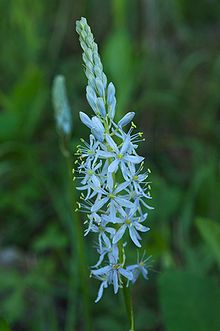bio.wikisort.org - Plant
Camassia scilloides is a perennial herb known commonly as Atlantic camas, wild hyacinth,[2] and eastern camas.[3] It is native to the eastern half of North America, including Ontario and the eastern United States.[3]
| Camassia scilloides | |
|---|---|
 | |
Conservation status | |
 Apparently Secure (NatureServe) | |
| Scientific classification | |
| Kingdom: | Plantae |
| Clade: | Tracheophytes |
| Clade: | Angiosperms |
| Clade: | Monocots |
| Order: | Asparagales |
| Family: | Asparagaceae |
| Subfamily: | Agavoideae |
| Genus: | Camassia |
| Species: | C. scilloides |
| Binomial name | |
| Camassia scilloides (Raf.) Cory. | |
| Synonyms[1] | |
|
Camassia esculenta | |
Description
The species produces inflorescences up to half a meter tall from a bulb 1–3 centimetres (0.39–1.18 in) wide.[4] It has a few leaves, each up to 20–60 cm (7.9–23.6 in) long.[4] The flowers have light blue or whitish tepals and yellow anthers. The green or brown capsule is up to a centimeter long[3] and divided into three parts.[4]
Uses
Native American groups used the bulbs for food, eating them raw, baked, roasted, boiled, or dried.[5] They can be used in place of potatoes, but could possibly be confused for poisonous deathcamas.[4]
Taxonomy
The superseded name Camassia esculenta (Ker Gawl.) B.L.Rob., (nom. illeg.)[6] should not be confused with Camassia esculenta (Nutt.) Lindl., a superseded name for Camassia quamash subsp. quamash.[7]
References
- Rhodora 10: 31 (1908)
- Camassia scilloides. NatureServe. 2012.
- Camassia scilloides. Flora of North America.
- Elias, Thomas S.; Dykeman, Peter A. (2009) [1982]. Edible Wild Plants: A North American Field Guide to Over 200 Natural Foods. New York: Sterling. p. 65. ISBN 978-1-4027-6715-9. OCLC 244766414.
- Camassia scilloides. Native American Ethnobotany. University of Michigan, Dearborn.
- World Checklist of Selected Plant Families: Camassia esculenta (Ker Gawl.) B.L.Rob.
- World Checklist of Selected Plant Families: Camassia esculenta (Nutt.) Lindl.
External links
 Media related to Camassia scilloides at Wikimedia Commons
Media related to Camassia scilloides at Wikimedia Commons- Camassia scilloides. USDA PLANTS
- Jalava, J. V. 2013. Recovery Strategy for the Wild Hyacinth (Camassia scilloides) in Ontario. Ontario Recovery Strategy Series. Ontario Ministry of Natural Resources, Peterborough.
Другой контент может иметь иную лицензию. Перед использованием материалов сайта WikiSort.org внимательно изучите правила лицензирования конкретных элементов наполнения сайта.
WikiSort.org - проект по пересортировке и дополнению контента Википедии